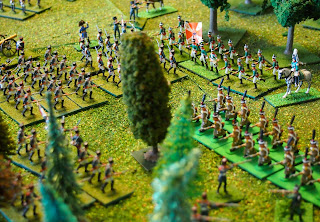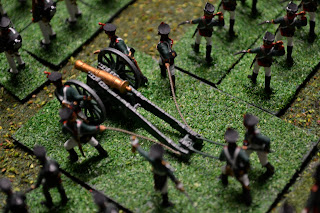Having completed, Borodino, we are now getting really ambitious and turning our attention to the big one; Leipzig. This is one of those wargaming ‘dreams’; something that I had never previously envisaged even contemplating doing. Our combined wargaming resources and the effort that we now know, thanks to Borodino, we can bring to such a project gives us some confidence that we can make it happen. We may not be ready by October 2013 though!
It is a daunting challenge.
The Battle of Leipzig, “Battle of the Nations”, was fought over four days. In its entirety the action occurred over an area of around 10 km x 10 km. It involved about half a million men; around 150 000–190 000 French-Allied and 300 000–350 000 Allies, these latter comprising Russians, Austrians, Prussians, Swedes.
We’d like to do our version of Leipzig at a figure scale of 1:50 and on a ground scale of 2 mm to 1 m. We have about a year to get ready if we are to stage it in time for the bicentennial next year and we are going to need every day of that!
Our first challenge is the table. At first we thought that we’d do the battle on the floor of the ANF HQ, thus taking advantage of the entire area of about 5 m x 5 m. While that would solve the problems of the size of table required and the restriction caused by the maximum reach of players operating from the edge of a table, the problems of player comfort, potential for treading on figures and what to do with the current contents of the ANF HQ have lead us back to the table.
The majority of the action was limited to an area close to 10 km x 8 km so, at our scale of 2 mm to 1 m—and taking a bit of licence, we can use a table 4.8 m long and 3.6 m wide (Map 1). That is the same length as our table for Borodino and 1.6 m wider. This second dimension introduces another problem: how does a player reach the centre of a table that is 3.6 m wide?!
 |
| Map 1: First draft of our proposed table for the Battle of Leipzig showing approximate positions of the initial forces on 16th October 1813. |
Our proposed solution to this is to use a ‘donut’ approach along with some ‘notches’ in the table (Map 2). The hole of the ‘donut’ is an area of 800 mm x 800 mm that can be lifted out of the table, thus creating a ‘man-hole’ inside the table from which a player can reach figures. This hole will be around the town of Leipzig (grey hatched area on map). We also propose to have several ‘notches’ cut out of the table to allow players to reach the areas that cannot be accessed either from the table sides or from within Leipzig. The perimeter of the resulting table is indicated by the red outline on the map. By these two means it should be possible to have all figures within about 1 m of the players (as indicated by the magenta arrows on the map).
We estimate the town of Leipzig will cover an area of 400 mm x 400 mm on the table, so will require 16 sets of 100 mm x 100 mm town sections. That will keep our master builder Julian in gameful ‘employ’!
 |
| Map 2: Proposed table for the Battle of Leipzig showing player reach (1 m) from the table edges and from within the Leipzig ‘man-hole’. |
Having ‘solved’ the problem of the table, our next challenge is the armies. We are looking at big numbers. We should have sufficient Russians and French-Allies already; or at least very close to it. The gaps that we need to fill are Prussians (mainly cavalry and artillery), Austrians and Swedes. By our preliminary calculations we will require over 2 000 figures to represent the Austrians and Swedes. These need to be done from scratch! I am working on the detailed orders of battle using Nafziger and Pigeard (below).
Always have a Plan B
At this stage we are aiming to do the entire battle for the bicentennial. It becomes evident that we are not going to make it for 2013, the fall back is to do the Mockern and Wachau/Liebertvolkwitz sectors of 16th October 1813 as separate battles around October 2013 and then to do the entire Battle of Leipzig in 2014.
We’ll keep you posted!
References
Pigeard, A (2009) Leipzig : La bataille des Nations (16-19 octobre 1813). Napoleon 1er Editions, St Cloud, France. 82 pp.











































































